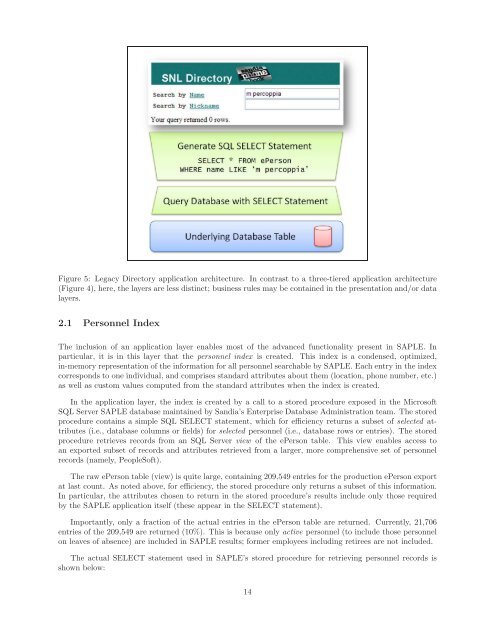SAPLE: Sandia Advanced Personnel Locator Engine - Mike Procopio
SAPLE: Sandia Advanced Personnel Locator Engine - Mike Procopio
SAPLE: Sandia Advanced Personnel Locator Engine - Mike Procopio
You also want an ePaper? Increase the reach of your titles
YUMPU automatically turns print PDFs into web optimized ePapers that Google loves.
Figure 5: Legacy Directory application architecture. In contrast to a three-tiered application architecture<br />
(Figure 4), here, the layers are less distinct; business rules may be contained in the presentation and/or data<br />
layers.<br />
2.1 <strong>Personnel</strong> Index<br />
The inclusion of an application layer enables most of the advanced functionality present in <strong>SAPLE</strong>. In<br />
particular, it is in this layer that the personnel index is created. This index is a condensed, optimized,<br />
in-memory representation of the information for all personnel searchable by <strong>SAPLE</strong>. Each entry in the index<br />
corresponds to one individual, and comprises standard attributes about them (location, phone number, etc.)<br />
as well as custom values computed from the standard attributes when the index is created.<br />
In the application layer, the index is created by a call to a stored procedure exposed in the Microsoft<br />
SQL Server <strong>SAPLE</strong> database maintained by <strong>Sandia</strong>’s Enterprise Database Administration team. The stored<br />
procedure contains a simple SQL SELECT statement, which for efficiency returns a subset of selected attributes<br />
(i.e., database columns or fields) for selected personnel (i.e., database rows or entries). The stored<br />
procedure retrieves records from an SQL Server view of the ePerson table. This view enables access to<br />
an exported subset of records and attributes retrieved from a larger, more comprehensive set of personnel<br />
records (namely, PeopleSoft).<br />
The raw ePerson table (view) is quite large, containing 209,549 entries for the production ePerson export<br />
at last count. As noted above, for efficiency, the stored procedure only returns a subset of this information.<br />
In particular, the attributes chosen to return in the stored procedure’s results include only those required<br />
by the <strong>SAPLE</strong> application itself (these appear in the SELECT statement).<br />
Importantly, only a fraction of the actual entries in the ePerson table are returned. Currently, 21,706<br />
entries of the 209,549 are returned (10%). This is because only active personnel (to include those personnel<br />
on leaves of absence) are included in <strong>SAPLE</strong> results; former employees including retirees are not included.<br />
The actual SELECT statement used in <strong>SAPLE</strong>’s stored procedure for retrieving personnel records is<br />
shown below:<br />
14
















